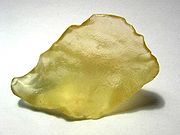
Libyan desert glass
Encyclopedia

Libyan Desert
The Libyan Desert covers an area of approximately 1,100,000 km2, it extends approximately 1100 km from east to west, and 1,000 km from north to south, in about the shape of a rectangle...
. Fragments of desert glass can be found over large areas, up to tens of kilometers.
Geologic origin
The origin of the glass is a controversial issue for the scientific community, with many evolving theories. MeteorMETEOR
METEOR is a metric for the evaluation of machine translation output. The metric is based on the harmonic mean of unigram precision and recall, with recall weighted higher than precision...
itic origins for the glass were long suspected, and recent research linked the glass
Glass
Glass is an amorphous solid material. Glasses are typically brittle and optically transparent.The most familiar type of glass, used for centuries in windows and drinking vessels, is soda-lime glass, composed of about 75% silica plus Na2O, CaO, and several minor additives...
to impact features, such as zircon
Zircon
Zircon is a mineral belonging to the group of nesosilicates. Its chemical name is zirconium silicate and its corresponding chemical formula is ZrSiO4. A common empirical formula showing some of the range of substitution in zircon is 1–x4x–y...
-breakdown, vaporized quartz
Quartz
Quartz is the second-most-abundant mineral in the Earth's continental crust, after feldspar. It is made up of a continuous framework of SiO4 silicon–oxygen tetrahedra, with each oxygen being shared between two tetrahedra, giving an overall formula SiO2. There are many different varieties of quartz,...
and meteoritic metals, and to an impact crater
Impact crater
In the broadest sense, the term impact crater can be applied to any depression, natural or manmade, resulting from the high velocity impact of a projectile with a larger body...
. Some geologists associate the glass not with impact melt ejecta, but with radiative melting
Thermal radiation
Thermal radiation is electromagnetic radiation generated by the thermal motion of charged particles in matter. All matter with a temperature greater than absolute zero emits thermal radiation....
from meteoric large aerial bursts
Air burst
An air burst is the detonation of an explosive device such as an anti-personnel artillery shell or a nuclear weapon in the air instead of on contact with the ground or target or a delayed armor piercing explosion....
. If that were the case, the glass would be analogous to trinitite
Trinitite
Trinitite, also known as Atomsite or Alamogordo Glass, is the name given to the glassy residue left on the desert floor after the plutonium-based Trinity nuclear bomb test on July 16, 1945, near Alamogordo, New Mexico...
, which is created from sand
Sand
Sand is a naturally occurring granular material composed of finely divided rock and mineral particles.The composition of sand is highly variable, depending on the local rock sources and conditions, but the most common constituent of sand in inland continental settings and non-tropical coastal...
exposed to the thermal radiation
Thermal radiation
Thermal radiation is electromagnetic radiation generated by the thermal motion of charged particles in matter. All matter with a temperature greater than absolute zero emits thermal radiation....
of a nuclear explosion
Effects of nuclear explosions
The energy released from a nuclear weapon detonated in the troposphere can be divided into four basic categories:*Blast—40-50% of total energy*Thermal radiation—30-50% of total energy...
. The Libyan desert glass has been dated as having formed about 26 million years ago. It was knapped and used as a tool during the Pleistocene
Pleistocene
The Pleistocene is the epoch from 2,588,000 to 11,700 years BP that spans the world's recent period of repeated glaciations. The name pleistocene is derived from the Greek and ....
Era.
See also
- TektiteTektiteTektites are natural glass rocks up to a few centimeters in size, which most scientists argue were formed by the impact of large meteorites on Earth's surface. Tektites are typically black or olive-green, and their shape varies from rounded to irregular.Tektites are among the "driest" rocks, with...
- Tunguska eventTunguska eventThe Tunguska event, or Tunguska blast or Tunguska explosion, was an enormously powerful explosion that occurred near the Podkamennaya Tunguska River in what is now Krasnoyarsk Krai, Russia, at about 7:14 a.m...
- Kebira craterKebira CraterKebira Crater is the proposed name for a circular topographic feature in the Sahara desert. The center of the feature lies in Libya, and the eastern edge extends into Egypt. Its discovery from satellite images was announced in March 2006 by researchers Dr. Farouk El-Baz and Dr...
- desert glass
- Darwin glassDarwin GlassDarwin glass is a natural glass found south of Queenstown in West Coast, Tasmania. It takes its name from Mount Darwin in the West Coast Range, where it was first reported, and later gave its name to Darwin Crater, a probable impact crater, and the inferred source of the glass.-Occurrence:Fragments...
Literature
- V. de Michele (ed.): Proceedings of the Silica '96 Meeting on Libyan Desert Glass and related desert events, Bologna, 1997 Contents
- P.A. Clayton / L.J. Spencer: Silica Glass from the Libyan Desert, Vortrag vom 09.11.1933 online

